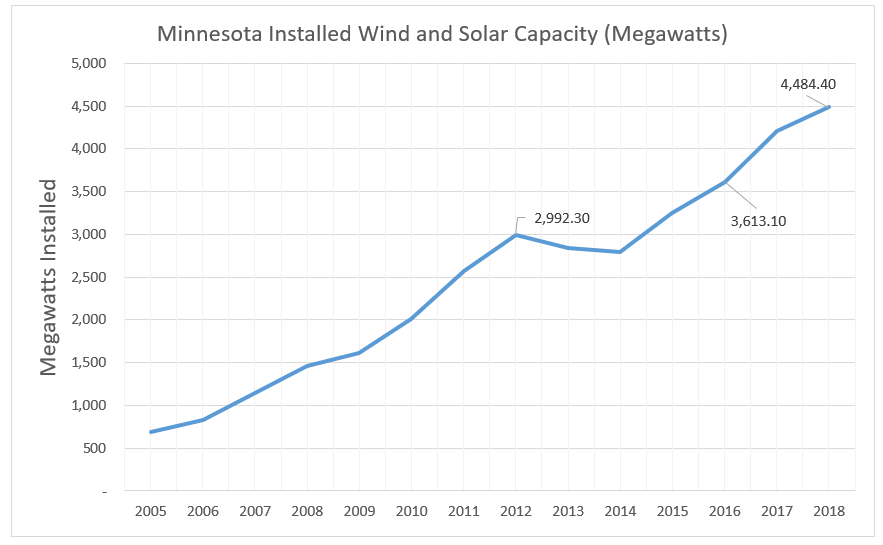Minnesota Had More Wind and Solar in 2018 than Ever Before But CO2 Emissions Went Up
Minnesota had more wind turbines and solar panels in 2018 than in any year prior, but carbon dioxide emissions from the electricity generation sector increased compared to 2017 and 2016 levels, according to the most recent data released by the U.S. Energy Information Administration (EIA).
According to EIA, Minnesota power plants emitted 29.8 million metric tons of carbon dioxide in 2018, compared to 28.3 million in 2017, and 29.6 million in 2016. This means our carbon dioxide emissions were about half a percent higher in 2018 than 2016, when we had much fewer wind turbines and solar panels installed in the Land of 10,000 Lakes.

The graph below shows the total installed capacity for wind and solar from 2005 to 2018. You’ll see that the amount of wind and solar on the grid has increased by 871 megawatts (approximately 24 percent) since 2016, yet carbon dioxide emissions increased during this time frame.

But why? One reason is that Minnesota generated less electricity from wind in 2018 than in 2017.
As you can see in the graph below, the amount of installed wind capacity in Minnesota reached a new all-time high in 2018 (so did electric bills), but wind generation was about four percent lower in 2018 than in 2017. There could be multiple reasons why the wind was less useful in 2018 than 2017, including lower wind speeds or mechanical failure, but regardless of the reason, the take away from the data should be the same: more wind turbines does not necessarily mean more electricity generation from wind.

This data presents an inconvenient reality for liberal politicians who claim human carbon dioxide emissions are causing an existential climate crisis.
How in the world can these politicians credibly claim that climate change is an existential crisis, while saying that we can only build impossibly expensive wind, solar, and battery storage when emissions have increased even though we have 24 percent more renewable capacity on the grid than we did in 2016?
Despite all of the sanctimonious platitudes wind and solar supporters spout about creating a better world for the children, they are not the adults in the room. If they were, they would seek to reduce emissions as cost effectively and efficiently as possible using a suite of technologies like new nuclear power, large hydro, and carbon capture and sequestration. Instead, they seem to always advocate for the opposite.
Minnesota’s renewable energy mandate is already harming every person in our state by increasing electricity prices. Xcel Energy’s recent bid to increase prices by $52 per year through the Renewable Energy Standard rider acts as one more regressive wind and solar tax, hurting low-income families and seniors the most. If we are going to build a stronger Minnesota for everyone, the foundation of our state should be lower energy prices, not higher ones.